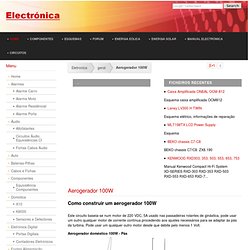

Aerogerador 100W - Electrónica - Esquemas - TV - Áudio - Digital. Como construir um aerogerador 100W Este circuito baseia-se num motor de 220 VDC, 5A usado nas passadeiras rolantes de ginástica, pode usar um outro qualquer motor de corrente contínua procedendo aos ajustes necessários para se adaptar ás pás da turbina.

Pode usar um qualquer outro motor desde que debite pelo menos 1 Volt. Aerogerador doméstico 100W - Pás A segurança é mais importante que a eletricidade, execute os circuitos usando o maior cuidado possível. Os geradores eólicos podem ser perigosos quando expostos a ventos fortes as peças móveis podem produzir estragos. Salvaguarde a sua segurança e a segurança do ambiente circundante. Materiais para o aerogerador Montagem Tubo 90Cm, 1" Diâmetro Centro de parabólica 2'' Motor 260 VDC, 5 A Ex: Motor de uma passadeira rolante 30 - 50 Amp Díodos ou ponte rectificadora 2 x 5/16” x ¾” Anilhas 3" X 28 Cm tubo de PVC Pá de Orientação 1 m2 (aprox) Plástico Rígido ou Metal 2 X ¾" Parafusos auto-roscantes - P.Porco.
Generate Electricity. A treadmill is a piece of indoor sporting equipment used to allow for the motions of running or walking while staying in one place.

The word treadmill traditionally refers to a type of mill which was operated by a person or animal treading steps of a wheel to grind grain (see treadwheel.) The principle is a belt system (an electric motor or flywheel connected to a circular run of material) where the top of the belt moves to the rear so as to allow a runner to run an equal, and necessarily opposite speed. Thus the speed of the run can easily be set or measured (the rate at which the belt moves is the rate at which the runner moves). The more expensive, heavy-duty versions are motor-driven. The simpler, lighter, cheaper versions are passive, moving only when the walker pushes the belt with their feet, and operates just to resist the motion. Some treadmills have special features such as step count, heart rate monitors, amount of calories expended. How can you hook up a tredmil to an electric generator to produce free electricity.
Can Exercise equipment be used to generate electricity. While it could be done, it would probably take a hundred years to pay back the investment in the electric machinery it would take to recoup any energy from exercisers.

Let's think it through... A person exercising fairly hard can generate perhaps 300 Watts averaged over an hour. Lets say your generator is 70% efficient. That means 200 Watts per treadmill or bicycle - perhaps if there are 50 machines there are only 30% (15) being used at a time so 15 times 200 equals 3000Watts. 3000W*1 hour is 3kW hours which costs about $0.25 (a quarter) So your exercise generator system makes you $4.00 per day, assuming that 30% of the machines are in use 16 hours per day (which is really optimistic) Your system would make the bikes or treadmills more expensive and you would need to install equipment to be able to use that energy, lets optimistically say that adds an extra $100000 for 50 special bikes/treadmills and a battery inverter system and all the necessary wiring, etc... MotorWave. Basic Principle of "Power by you" All modern equipment in gyms are equipped with an internal generator to power the control board that people watch and adjust when training.The different resistance levels are controlled by electronic regulators controlling the value of a resistor.

The energy spent by the machine user is simply converted into heat (P=RI*2).The idea is that instead of converting this energy into heat, we collect this energy to charge a rechargeable battery. The energy collected can then be used to power the lighting system of the gym.Technically there are no major obstacles. The generator delivers a voltage between 15 to 70 volts depending on the rotation speed of the equipment. By connecting it directly to a 24 volt battery (through an AC/DC converter), the voltage drops to 25 volts regardless of the generator output.Only the current changes.A user will produce from 20 to 100 watts depending on their physical capacity We then have between 0.8 to 4 amperes produced.